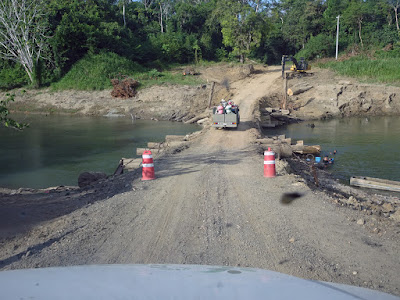Wednesday 2/14/18 - Continued.
Lunch was served by a
beautiful clear river. There was plenty
to eat and drink thanks to these helpful guys.
I am a Harpy Fan.
Waiting for lunch.
Lunch by the river.
This Uranium Moth landed on someones shirt.
We started hiking back
much more slowly. At one point a Red-throated Caracara perched overhead and called over and over.
On the tiny end of the scale, a Ruddy-tailed Flycatcher perched nearby.
Ruddy-tailed Flycatcher
There were many trails
of leaf cutter ants. They were very
interesting to watch.
Leaf cutter ants at work.
Leaf cutter ants
crossing the water.
We saw a large Mealy Parrot in a tree on the way back. They are almost the same color as the leaves and can be remarkably difficult to spot.
Mealy Parrot
It turns out that huge black and red woodpeckers are much easier to spot!!
Crimson-crested Woodpecker female
When we arrived back
at the trucks the local women had spread out hand-crafts for us to
purchase. I had fun picking out a couple
of things to buy. They were very
well-made.
A few souvenirs.
We hopped back in the
4-wheel drive trucks for the trip back to the dug-out canoes. We happened to get into a different truck
this time and it was extremely uncomfortable.
Back over the river
crossings.
There are some very large trees in the jungle!
Very large seed pods too!
We got back in the
canoes and took off for Yaviza.
Loading up.
Leaving the dock.
The river looked a lot
different in the daylight!
The rest of our group.
After about an hour on the water we were back where we started.
Coming into Yaviza.
This time the area was
bustling with activity.
Lots of boats filled
with plantains being unloaded.
Unloading the boats.
The plantains were
then loaded onto trucks for distribution throughout the country.
Loading the trucks for distribution.
We got back into our
two vans for the hour drive back to Camp.
Since we arrived late, dinner was served at 7:30 p.m.
It had been a very
long day.
Next time: More birding in the Darien.
Birds seen 2/14/18:
Muscovy duck, Marbled Wood-Quail (H), Pale-vented Pigeon, Ruddy Pigeon (H), Ruddy Ground-Dove, Squirrel Cuckoo (H), Greater Ani, Smooth-billed Ani, Common Pauraque, Pale-bellied Hermit, Black-throated Mango, Blue-Chested Hummingbird, Southern Lapwing, Spotted Sandpiper, Neotropic Cormorant, Anhinga, Great Blue Heron, Cocoi Heron, Great Egret, Snowy Egret, Little Blue Heron, Tricolored Heron, Cattle Egret, Striated Heron, Black-crowned Night-Heron, Yellow-crowned Night-Heron, White Ibis, Black Vulture, Turkey Vulture, King Vulture, Swallow-tailed Kite, Double-toothed Kite, Plumbeous Kite, Common Black Hawk, Savanna Hawk, Roadside Hawk, Harpy Eagle, Black-tailed Trogon (H), White-tailed Trogon (H), Gartered Trogon (H), Whooping Motmot (H), Ringed Kingfisher, Gray-cheeked Nunlet, Collared Aracari, Keel-billed Toucan (H), Cinnamon Woodpecker (H), Crimson-crested Woodpecker, Red-throated Caracara, Crested Caracara, Yellow-headed Caracara, Blue-and-Yellow Macaw, Orange-chinned Parakeet, Blue-headed Parrot, Red-lored Parrot, Mealy Parrot, Moustached Antwren, Rufous-winged Antwren (H), Dot-winged Antwren, Chestnut-backed Antwren (H), Black-crowned Antpitta, Cocoa Woodcreeper, Streak-headed Woodcreeper, Plain Xenops, Black-capped Pygmy-Tyrant, Black-headed Tody-Flycatcher, Golden-crowned Spadebill, Ruddy-tailed Flycatcher, Sulphur-rumped Flycatcher, Black-tailed Flycatcher, Bright-rumped Atttila (H), Choco Sirystes, Great Kiskadee, Sulphur-bellied Flycatcher, Piratic Flycatcher, Tropical Kingbird, Fork-tailed Flycatcher, Russet-winged Schiffornis, Masked Tityra, Cinnamon Becard, Purple-throated Fruitcrow (H), Rufous Piha, Golden-collared Manakin (H), Golden-headed Manakin, Lesser Greenlet (H), Black-chested Jay, Gray-breasted Martin, Mangrove Swallow, Southern Rough-winged Swallow, Cliff Swallow, Black-bellied Wren (H), Stripe-throated Wren, White-breasted Wood-Wren, Tropical Gnatcatcher, Yellow-crowned Euphonia (H), Bay-breated Warbler (H), Blue-gray Tanager, Palm Tanager, Plain-colored Tanager, Green Honeycreeper, Blue Dacnis, Variable Seedeater, Great-tailed Grackle, Crested Oropendola, Chestnut-headed Oropendola, Black Oropendola.
Hoffmann's two-toed Sloth, Panamanian Night Monkey, Yellow-headed Gecko, Tropical Squirrel, House Gecko, Uranium Moth.






































































